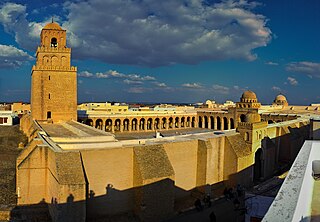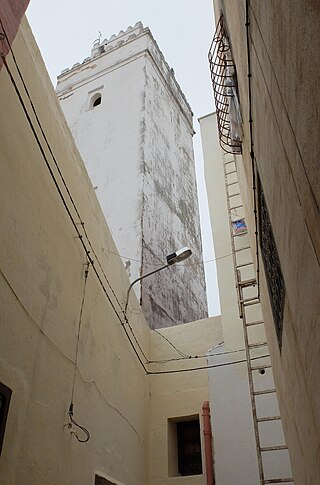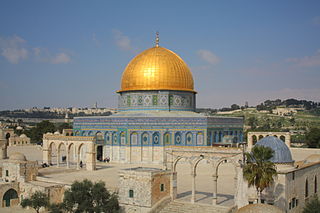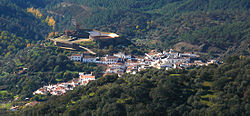
The Mosque–Cathedral of Córdoba, officially known by its ecclesiastical name of Cathedral of Our Lady of the Assumption, is the cathedral of the Roman Catholic Diocese of Córdoba dedicated to the Assumption of Mary and located in the Spanish region of Andalusia. Due to its status as a former mosque, it is also known as the Mezquita and as the Great Mosque of Córdoba.

The Kutubiyya Mosque or Koutoubia Mosque is the largest mosque in Marrakesh, Morocco. The mosque's name is also variably rendered as Jami' al-Kutubiyah, Kutubiya Mosque, Kutubiyyin Mosque, and Mosque of the Booksellers. It is located in the southwest medina quarter of Marrakesh, near the famous public place of Jemaa el-Fna, and is flanked by large gardens.

The Great Mosque of Kairouan, also known as the Mosque of Uqba, is a mosque situated in the UNESCO World Heritage town of Kairouan, Tunisia and is one of the most impressive and largest Islamic monuments in North Africa.

Moorish architecture is a style within Islamic architecture which developed in the western Islamic world, including al-Andalus and what is now Morocco, Algeria, and Tunisia. Scholarly references on Islamic architecture often refer to this architectural tradition by a more geographic designation, such as architecture of the Islamic West or architecture of the Western Islamic lands. The use of the term "Moorish" comes from the historical Western European designation of the Muslim inhabitants of these regions as "Moors". Some references on Islamic art and architecture consider this term to be outdated or contested.

San Pedro de la Nave is an Early Medieval church in the province of Zamora, Spain. It is in the locality of El Campillo in the municipal unit of San Pedro de la Nave-Almendra. It was moved from its original site near the River Esla when the land was to be flooded by the construction of the Ricobayo reservoir.

The Great Mosque of Taza is the most important religious building in the historic medina of Taza, Morocco. Founded in the 12th century, it is the oldest surviving example of Almohad architecture, although it was expanded by the Marinids in the late 13th century.

Djamaa el Kebir, also known as the Great Mosque of Algiers, is a historic mosque in Algiers, Algeria. It is located within the Casbah, near the city's harbor. Dating to 1097, it is one of the few remaining examples of Almoravid architecture, although it has undergone other additions and reconstructions since its foundation. It is the oldest mosque in Algiers and is said to be one of the oldest mosques in Algeria after Sidi Okba Mosque and Sidi Ghanem Mosque.

Choto Shona Mosque is located in Chapai Nawabganj district of Bangladesh. The mosque is situated about 3 kilometres (1.9 mi) south of the Kotwali Gate and 0.5 kilometres (0.31 mi) to the south-east of the Mughal Tahakhana complex in the Firozpur Quarter.

Almohad architecture corresponds to a period from the 12th to early 13th centuries when the Almohads ruled over the western Maghreb and al-Andalus. It was an important phase in the consolidation of a regional Moorish architecture shared across these territories, continuing some of the trends of the preceding Almoravid period and of Almoravid architecture.

The Great Mosque of Mahdiya is a mosque that was built in the tenth century in Mahdia, Tunisia. Located on the southern side of the peninsula on which the old city was located, construction of the mosque was initiated in 916, when the city was founded by the Fatimid caliph Abdallah al-Mahdi, to serve as the new city's main mosque. Most of the Fatimid-era city and its structures have since disappeared. The current mosque was largely reconstructed by archeologists in the 1960s, with the exception of its preserved entrance façade.

Umayyad architecture developed in the Umayyad Caliphate between 661 and 750, primarily in its heartlands of Syria and Palestine. It drew extensively on the architecture of older Middle Eastern and Mediterranean civilizations including the Sassanian Empire and Byzantine Empire, but introduced innovations in decoration and form. Under Umayyad patronage, Islamic architecture began to mature and acquire traditions of its own, such as the introduction of mihrabs to mosques, a trend towards aniconism in decoration, and a greater sense of scale and monumentality compared to previous Islamic buildings. The most important examples of Umayyad architecture are concentrated in the capital of Damascus and the Greater Syria region, including the Dome of the Rock, the Great Mosque of Damascus, and secular buildings such as the Mshatta Palace and Qusayr 'Amra.

The Kasbah Mosque is a historic mosque in Marrakesh, Morocco. It was originally built by the Almohad caliph Yaqub al-Mansour in 1185-1190 CE. It is located in the Kasbah district, the city's former citadel, near the site of its historic royal palaces. Along with the Kutubiyya Mosque, it is one of the most important historic mosques in Marrakesh.

The Bab Doukkala Mosque or Mosque of Bab Doukkala is a major neighbourhood mosque in Marrakesh, Morocco, dating from the 16th century. It is named after the nearby city gate, Bab Doukkala, in the western city walls. It is also known as the al-Hurra Mosque.

The Mouassine Mosque or al-Muwassin Mosque is a major neighbourhood mosque in Marrakech, Morocco, dating from the 16th century during the Saadian dynasty. It shares its name with the Mouassine neighbourhood.

The Bou Jeloud Mosque is a historic Almohad-era mosque in the former Kasbah of Bou Jeloud, located near Bab Bou Jeloud, in Fes, Morocco.

The Great Mosque of Fes el-Jdid is the historic main Friday mosque of Fes el-Jdid, the royal city and Marinid-era citadel of Fes, Morocco. It is believed to have been founded in 1276, around the same time that the city itself was founded, making it the oldest mosque in Fes el-Jdid.

The Lalla ez-Zhar Mosque, or al-Zahr Mosque, is a mosque located in Fes el-Jdid in the historic old city of Fez, Morocco. It is also known by the name Jama’ el-Hajjar, probably in reference to its stone portal entrance. The mosque was founded or completed in 1357 CE by the Marinid sultan Abu Inan.

The Zawiya of Sidi Bel Abbes or Zaouia of Sidi Bel-Abbès is an Islamic religious complex (zawiya) in Marrakesh, Morocco. The complex is centered around the mausoleum of Abu al-Abbas as-Sabti, a Sufi teacher who died in 1204. He is the most venerated of the Seven Saints of Marrakesh, generally considered the "patron saint" of the city. The zawiya's architecture dates in part to the late Saadian period but has been modified and restored multiple times since then.

The Tinmal Mosque or Great Mosque of Tinmal is a 12th-century mosque located in the village of Tinmel in the High Atlas Mountains of Morocco. Although no longer operating as a mosque today, its remains are preserved as a historic site. It was built at the site where Ibn Tumart, the founder of the Almohad movement, was buried and it is considered an important example of Almohad architecture.

Aghlabid architecture dates to the rule of the Aghlabid dynasty in Ifriqiya during the 9th century and the beginning of the 10th century. The dynasty ruled nominally on behalf of the Abbasid Caliphs, with which they shared many political and cultural connections. Their architecture was heavily influenced by older antique architecture in the region as well as by contemporary Abbasid architecture in the east. The Aghlabid period is also distinguished by a relatively large number of monuments that have survived to the present day, a situation unusual for early Islamic architecture. One of the most important monuments of this period, the Great Mosque of Kairouan, was a model for mosque architecture in the region. It features one of the oldest minarets and contains one of the oldest surviving mihrabs in Islamic architecture.


























